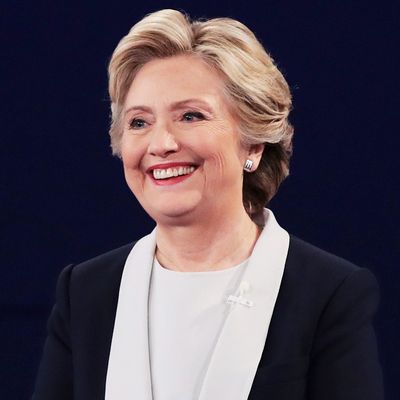
In just three weeks, the 2016 campaign will be over and the speculation about 2020 (and/or when the Trumpist militias will relinquish control of Mississippi) will begin.
So, where do the most recent polls put this race, with 21 days to go? Here are five takeaways:
Hillary Clinton is almost certainly going to be president.
On Monday, CNN’s new “poll of polls” — an average of the four most recent national surveys that meet the network’s standard — put Clinton ahead of Trump by 8 percent.
One of those surveys was George Washington University’s Battleground Poll, which also found Clinton leading the GOP nominee by eight points. The same poll had Clinton up by only 2 percent in early September. In that earlier survey, Gary Johnson and Jill Stein were collectively polling three points higher than they are now, with the Libertarian claiming 8 percent and the Green Party nominee just 2 percent.
A Politico/Morning Consult poll out Monday finds Clinton leading Trump 42 to 36 percent in a four-way race. After the vice-presidential debate, Trump had climbed to 39 percent, but grab’em by the pussy-gate and last week’s wave of sexual-assault allegations have pulled the GOP nominee back to where he stood after he bragged about tax evasion at the first debate. Clinton’s support has hovered around 42 percent in the poll for all of October.
As of this writing, FiveThirtyEight’s Polls Only forecast gives Clinton an 87 percent chance of taking the Oval Office next January.
Clinton’s strategy of separating Trump from the GOP may be hurting down-ballot Democrats.
Respondents to GWU’s survey preferred Clinton to Trump by eight points, but opted for a Democratic Congress over a Republican one by only five. More concerning, the public seems to see little relationship between Trump’s issue positions and that of his party. Per George Washington University:
“While Trump trails Clinton on every issue tested on the issue handling series, the Republican Party has the advantage over the Democrats on a variety of issues, including the economy by an 18-point margin, taxes by an 11-point margin, jobs by a 6-point margin and foreign affairs by an 8-point margin,” said pollster Ed Goeas, president and CEO of The Tarrance Group. “Republican candidates across the country will be able to run with the advantage in the minds of voters on the key kitchen table issues and on one of the signature issues of the Clinton campaign, foreign affairs. With or without the active assistance of Trump, Republican candidates will be able to run as their own independent entities, whose electoral fortunes will not be tied to the sinking presidential candidate of their party.”
Democrats have generally led the generic congressional ballot by a narrower margin than Clinton has led the presidential race. RealClearPolitics’s generic ballot has Team Blue up by five percent, while their polling average for the presidential race puts Clinton up by 6.3 percent.
It’s possible that Clinton’s strategy of isolating Trump from the GOP has contributed to this discrepancy. However, it’s also possible that Trump, through his singular lack of qualifications for the presidency, has generated the gap virtually on his own.
Regardless, Democrats’ best hope is that Trump’s large deficit will depress Republican turnout, as would-be ticket splitters decide they don’t care enough about local races to wait out the line at their polling places.
Alaska’s feeling uncharacteristically blue.
A new poll from Lake Research Group finds Trump beating Clinton by a single point in Alaska — well within the survey’s 4.4 percent margin of error.
The last time the poll was taken in early August, Trump led Clinton 38 to 30 percent in a four-way race; now, he leads 37 to 36.
Alaska isn’t the only longtime red state that’s flirting with a change of color. At present, FiveThirtyEight has Arizona wearing the faintest shade of blue, and Clinton is within striking distance in Georgia.
Trump’s campaign message is getting through.
Over the past week, Donald Trump’s central message has been that it will not be his fault if he loses in November. At rallies, in interviews, and via Twitter, the GOP nominee has predicted that the election will be rigged against — both in a figurative sense, due to media bias, and in a literal sense, due to fraud at polling places in (implicitly) African-American communities.
That message is getting through: The Politico/Morning Consult poll finds that 41 percent of the electorate — including 73 percent of Republicans — think the election could be “stolen” from Donald Trump.
The Democratic Party is trading white working-class voters for suburban Republicans.
The 2016 campaign is accelerating a long-term realignment that’s pushing more college-educated white voters into the Democratic coalition, while more non-college-educated whites defect to the GOP tent.
This movement has reshaped the battleground map, as the Republican nominee performs strongest in Iowa, Ohio, and Nevada — where non-college-educated whites outnumber white degree-holders by 30, 24, and 18 percent, respectively — while states where the ratio is closer to even, like Colorado and Virginia, have become firmly Democratic.
As David Wasserman notes in the New York Times, the Clinton campaign has made a strategic choice to focus on winning over suburban Republicans, instead of working to retain Obama’s share of the white working-class vote against a populist like Trump.
The Clinton campaign calculates that its candidate is likelier to prevail by “disqualifying” Mr. Trump — using ads to make the idea of voting for him socially unacceptable in professional suburbs — among additional well-educated voters (in states like North Carolina) than by holding on to working-class voters tempted by Mr. Trump’s populism (in states like Ohio).
The Clinton campaign and its allies have run fewer ads puncturing Mr. Trump’s credentials as a business savior or painting a picture of what the economy might look like for middle-income earners under a Trump presidency. That strategy carries risks. In 2012, President Obama was able to keep states like Iowa, Ohio and Wisconsin in his column with early and effective ads linking Mitt Romney to Bain Capital and Cayman Islands bank accounts … In 2016, however, many surveys have shown Mr. Trump holding a lead in Iowa and running nearly even in Ohio.
This realignment is likely to heighten tensions within both parties. In the GOP, a larger downscale wing will only expand the gap between the preferences of Republican donors and the party’s voting base, while the Democratic Party’s growing upscale wing will be increasingly at odds with the party’s activist base on issues of taxes and government spending.






























